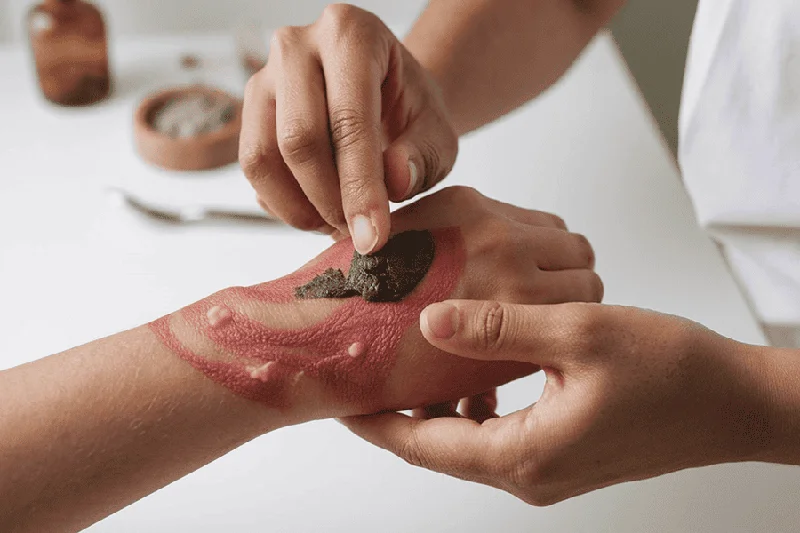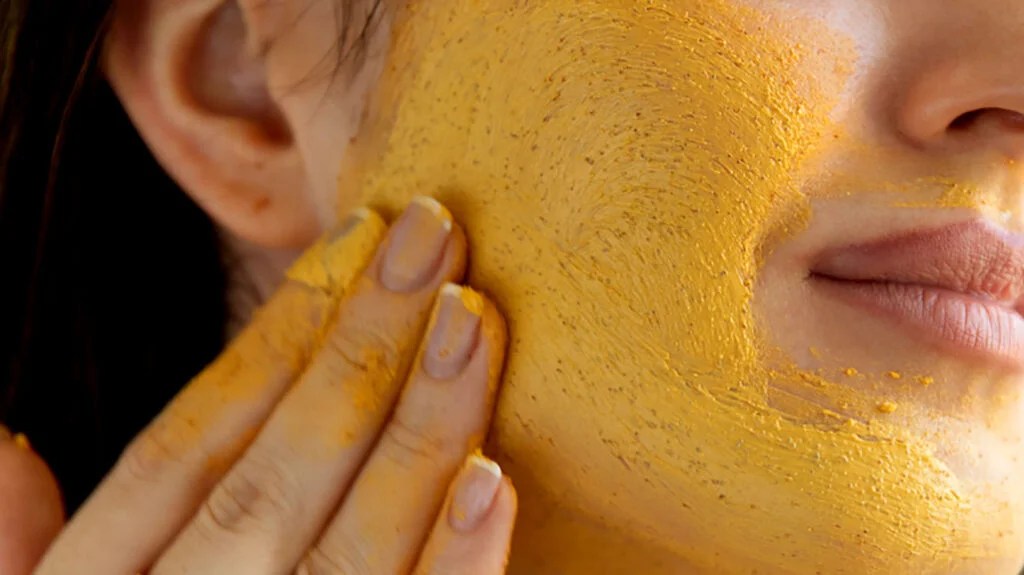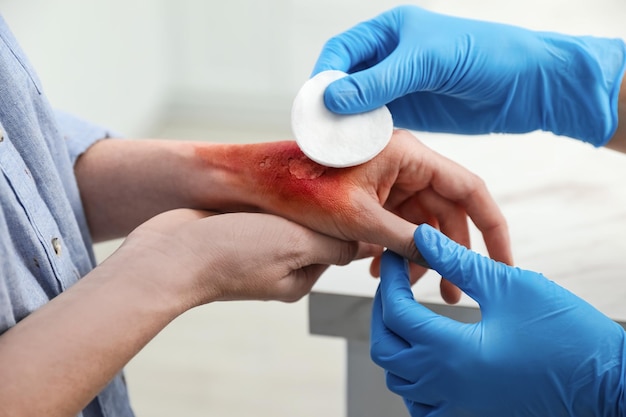Ask Ayurvedic doctor a question and get a consultation online on the problem of your concern in a free or paid mode. More than 2,000 experienced doctors work and wait for your questions on our site and help users to solve their health problems every day.
Shop Now in Our Store
Dushta Vrana – Ayurvedic Management of Chronic & Infected Wounds

Introduction to Dushta Vrana
Dushta Vrana refers to chronic or infected wounds that do not heal properly, as understood in Ayurvedic medicine. This traditional approach emphasizes cleansing, detoxification, and the balancing of doshas to promote effective wound healing. By integrating Ayurvedic remedies into the treatment of dushta vrana, individuals can support natural tissue regeneration, reduce inflammation, and restore overall skin health.
Historical Roots & Ayurvedic Significance
In Ayurveda, dushta vrana has been recognized as a condition resulting from an imbalance of the body’s doshas, particularly Pitta and Kapha. Ancient Ayurvedic texts describe specific herbal formulations and therapeutic procedures for managing these wounds. The focus on cleansing and detoxification, along with the application of medicated pastes and oils, underscores the holistic approach that Ayurveda brings to wound management and tissue repair.
Key Components & Therapeutic Benefits
Herbal Composition
The management of dushta vrana in Ayurveda involves a combination of potent herbs and natural substances, including:
- Turmeric (Haridra): Known for its anti-inflammatory and antimicrobial properties, it aids in cleansing the wound.
- Neem (Azadirachta indica): Acts as a natural disinfectant and supports healing.
- Tulsi (Ocimum sanctum): Offers antibacterial benefits and helps soothe inflammation.
- Aloe Vera: Provides cooling relief, accelerates tissue repair, and reduces irritation.
- Honey: Acts as a natural antiseptic and promotes moist wound healing.
These ingredients work synergistically to cleanse the wound, reduce infection, and stimulate the healing process.
Detoxification & Dosha Balancing
The treatment of dushta vrana emphasizes the detoxification of the affected area by eliminating accumulated toxins (ama) that hinder the healing process. Ayurvedic therapies are designed to balance the aggravated Pitta and Kapha doshas, which are often responsible for inflammation and stagnation in chronic wounds. This detoxifying action not only aids in wound healing but also improves overall skin health and resilience.
Rejuvenation & Tissue Regeneration
A core benefit of the Ayurvedic approach to dushta vrana is its ability to stimulate tissue regeneration. The nourishing properties of herbal pastes and medicated oils help rebuild damaged tissues, accelerate granulation, and promote the formation of healthy skin. This rejuvenative effect is crucial for restoring both the function and appearance of the skin after chronic or infected wounds.
Enhancing Skin Health & Preventing Recurrence
Beyond immediate wound healing, Ayurvedic management of dushta vrana focuses on long-term skin health. By addressing the root causes of the wound, such as dosha imbalances and toxin accumulation, this approach helps prevent recurrence and reduces the likelihood of scarring. Maintaining a balanced diet, proper hygiene, and regular application of Ayurvedic remedies are key factors in sustaining healthy skin.
How Dushta Vrana Management Works: The Science Behind the Therapy
The Ayurvedic treatment of dushta vrana integrates both topical and systemic approaches. Topical applications, including herbal pastes and medicated oils, work directly on the wound to cleanse, reduce inflammation, and stimulate tissue repair. Systemically, herbal decoctions and dietary modifications help balance doshas and eliminate toxins, thus supporting the body’s innate healing mechanisms. This comprehensive strategy ensures that the wound is not only healed but that the overall skin integrity is restored and fortified.
Choosing the Right Ayurvedic Remedies & Guidance
When addressing dushta vrana, it is essential to:
- Consult with Certified Ayurvedic Practitioners: Personalized guidance ensures that treatments are tailored to your specific condition and body constitution.
- Ensure High-Quality Ingredients: Use authentic herbs and natural substances to maximize efficacy and safety.
- Follow a Comprehensive Regimen: Incorporate both topical applications and systemic therapies for optimal wound healing and prevention of recurrence.
Recommended Dosage & How to Use Dushta Vrana Remedies
Treatment protocols for dushta vrana are customized based on the severity of the wound and individual health conditions. Generally, the regimen includes:
- Topical Applications: Apply herbal pastes, medicated oils, or honey-based formulations directly to the wound as advised by your practitioner.
- Systemic Support: Consume herbal decoctions or supplements that help detoxify and balance the doshas.
- Diet & Lifestyle: Follow specific dietary guidelines and maintain proper hygiene to support the healing process and prevent further infection.
- Professional Monitoring: Regular consultations with an Ayurvedic expert ensure that the treatment is effective and adjusted as needed.
Potential Side Effects & Precautions
While Ayurvedic remedies for dushta vrana are generally safe, certain precautions are necessary:
- Allergic Reactions: Some individuals may be sensitive to specific herbs. Discontinue use if you experience any signs of allergic reaction.
- Infection Control: Ensure that all topical applications are prepared under hygienic conditions to prevent further infection.
- Professional Supervision: Chronic wounds require careful monitoring. Always seek guidance from a certified Ayurvedic practitioner to tailor the treatment to your needs.
Frequently Asked Questions
What is dushta vrana and how is it managed in Ayurveda?
Dushta vrana refers to chronic or infected wounds that resist healing. Ayurveda manages these wounds by using a combination of detoxification, dosha balancing, and herbal therapies to cleanse the wound and stimulate tissue regeneration.
What herbs are commonly used in the treatment of dushta vrana?
Commonly used herbs include turmeric, neem, tulsi, aloe vera, and honey. These ingredients offer anti-inflammatory, antimicrobial, and healing properties that are essential for treating chronic wounds.
How does Ayurvedic treatment promote wound healing?
Ayurvedic treatment promotes wound healing by cleansing the wound, reducing inflammation, balancing doshas, and stimulating tissue regeneration through both topical applications and systemic support.
Can Ayurvedic remedies prevent the recurrence of dushta vrana?
Yes, by addressing the underlying dosha imbalances and detoxifying the body, Ayurvedic remedies not only heal the wound but also strengthen the skin’s natural defenses, reducing the risk of recurrence.
What lifestyle changes support the healing of dushta vrana?
A balanced diet, proper hygiene, and stress management are crucial. Following the dietary guidelines and lifestyle recommendations provided by your Ayurvedic practitioner can significantly enhance the healing process.
How long does it take to see improvements in dushta vrana with Ayurvedic treatment?
The time frame for healing can vary depending on the severity of the wound and individual health conditions. Some may observe improvements within a few weeks, while more chronic cases may require a longer period of treatment.
Where can I find authentic Ayurvedic remedies for dushta vrana?
Authentic remedies should be obtained from reputable Ayurvedic pharmacies or certified practitioners who ensure the quality and purity of the herbs and formulations used in treatment.
Conclusion & Expert Insights
The Ayurvedic approach to managing dushta vrana offers a comprehensive and natural method for healing chronic wounds. By focusing on detoxification, dosha balancing, and tissue regeneration, these therapies not only heal the wound but also enhance overall skin health and prevent recurrence. For those seeking a holistic and time-tested solution, consulting with a certified Ayurvedic practitioner is essential to tailor the treatment to your unique needs and achieve optimal healing outcomes.
References & Further Reading
- Sharma, P.V. (1995). Ayurvedic Healing: A Comprehensive Guide.
- Lad, V. (2002). Ayurveda: The Science of Self-Healing.
- National Institute of Ayurveda:
- Journal of Ayurveda and Integrative Medicine for research articles on wound healing and Ayurvedic therapies.
This article is checked by the current qualified Dr. Harsha Joy and can be considered a reliable source of information for users of the site.



